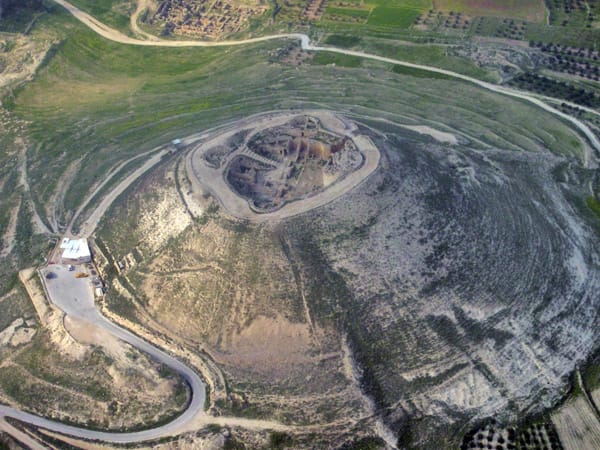
This Wednesday night, a few minutes before sunset, Zahava and I will put the kids into the car and drive twenty minutes east into the Judean Desert. Our destination: the ruins of King Herod’s mountain fortress; Herodion.
We won’t be alone in our journey.
Like the scene from the end of the film ‘Field of Dreams’ (where the long line of headlights weaves slowly through the cornfields at dusk)… the procession of cars will wind through the desert landscape towards a mountain that looks, for all the world, like a volcano.
Along the way, the winding road will take us through several Arab villages, so that the army patrols, checkpoints, and border police set up along the route will put our mind somewhat at ease.
In years past when we have made this erev Tisha B’Av trip, each time we have come upon a soldier or policeman, we have been greeted with the traditional, “Tzom Kal” (translation: [your] fast [should be] easy). This at first took us by surprise since the overwhelming majority of the soldiers serving out here in the hills of Judea are not religiously observant.
In their homes around the country, they may, or may not, have marked Tisha B’Av by fasting or reading the book of Lamentations. But being Jewish… and wearing the uniform of Israel’s modern army on the anniversary of the ruin of our ancient national aspirations… these teenaged Jewish soldiers offer us this traditional greeting as if to acknowledge their connection to the date… and to the place.
Another reason Jews traditionally wish one another an ‘easy fast’, is because one shouldn’t offer normal greetings (such as ‘Hi’, ‘How are you?’, etc.) on a day of mourning. Handshakes and hugs are also not exchanged, and even within a crowd, one is encouraged to refrain from levity.

As we approach Herodion, the volcano-like appearance will become more pronounced in the light of the setting sun. King Herod, who also built the mountain fortress of Masada, essentially took this mountain… sliced off the top… and scooped out the insides before constructing a desert palace for himself. When he was finished, he pushed even more dirt up around the sides of his palace.
Long after Herod was gone from the scene, this fortress became a refuge for Jews fleeing the destruction being wrought by Titus’ Roman Legions. The Jews who stood on top of Herodion on Tisha B’Av in 70 C.E. were able to clearly see the smoke and flames from Jerusalem as the Temple was being destroyed. Their feeling of hopelessness must have been overwhelming! As we climb this mountain fortress each year on the anniversary of that destruction, the connection to the past is inescapable.
And so we come each year to this same spot to sit on the stones and on the ground… the way they must have sat… in order to continue mourning over those terrible events.

Since it is inappropriate to exchange greetings on Tisha B’Av, the hundreds of people streaming up onto the mountain will acknowledged one another with nods, weak smiles and the inevitable ‘Tzom Kal’. This reserved behavior is meant to further emphasize the sense of loss, and will set the tone for the scene inside the mountain fortress.
As we descended the stairs/ ramp into the ruined fortress interior, the broken pillars, tumbled building stones, and whispering desert wind will further hush the assembled crowd until nearly all available space will be filled with somber mourners, seated uncomfortably in the dust.
As the sun sets in the distance, the assembled group of people will rise to their feet, turn as one to face Jerusalem and began the evening service (Aravit).
The adults will pray and the children will wander tentatively through the crowds. Even thought the usually rambunctious Israeli kids will be less aware of the specifics of the occasion (no hurry… they will learn the heartrending details soon enough)… they are always markedly more reserved in this setting, having taken their cues from the demeanor of the adults.
After the conclusion of the evening service, the crowd will break up into smaller groups, seeking out little sheltered niches around the windy mountain top and begin reading the book of Eichah (Lamentations) aloud.
I have heard Eichah read every year since I became observant at 18, but have always had trouble connecting the comfortable surroundings of the synagogue with the destruction described in the book. Sitting in the dust with my back against a broken pillar… there is no such disconnect.
The circumstances separating the assembled crowd on Herodion from the crowd that sat and mourned here in 70 C.E., are that we have a small glimmer of hope… ‘The first flowering of the redemption’… waiting for us outside this ruined fortress.
Even as our country is embattled on two fronts and often from within, we take comfort and pride that there are once again Jewish soldiers manning the ramparts of a sovereign Jewish state. Despite the best efforts of those who would gladly see us once again led into slavery (or worse), we are privileged this (and please G-d every) year, to brush away the dust… walk down the mountain… and resume writing the story that was interrupted almost two millennia ago.
David Bogner, formerly of Fairfield, CT, lives in Efrat with his wife Zahava (nee Cheryl Pomeranz), and their children Ariella, Gilad and Yonah. Since moving to Israel in 2003 David has been working in Israel’s defense industry on International Marketing and Business Development. In his free time David keeps a blog (www.treppenwitz.com) and is an amateur beekeeper.
* All images are © the Israel Ministry of Tourism.
The words of this author reflect his/her own opinions and do not necessarily represent the official position of the Orthodox Union.
